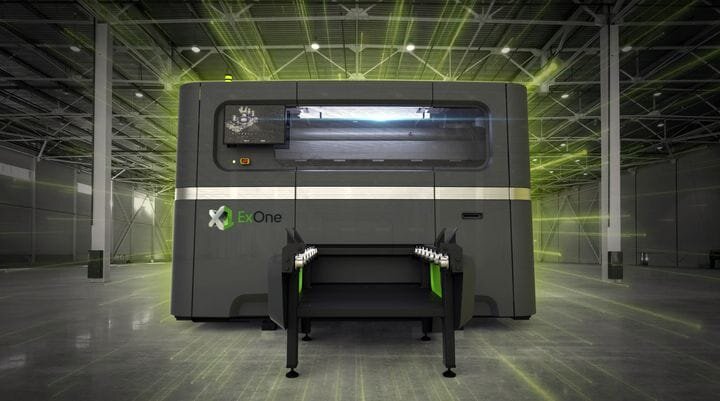![The ExOne X1 160PRO metal 3D printer [Source: ExOne]](https://fabbaloo.com/wp-content/uploads/2020/05/image-asset_img_5eb08d5bb20b4.jpg)
ExOne announced a brand new metal 3D printer today, the X1 160PRO.
If you think the image of the new X1 160PRO looks somewhat reminiscent of their previous X1 25PRO, you would not be mistaken. The X1 160PRO seems to be a much larger version of the previous machine.
Both machines employ ExOne’s Triple Advanced Compaction Technology (ACT) technology to enable successful 3D printing of very fine metal powder using a binder jetting approach.
Metal 3D Print Binder Jetting
Binder jetting is one of the major 3D printing processes, and its used by several vendors to print metals, ceramics and even thermoplastics. In this case, the X1 series are able to 3D print metal and ceramics.
The binder jetting process involves first spreading out an extremely flat layer of loose powder, and in the case of the X1 series, it’s ultra fine metal powder with particles having a diameter of around 0.009mm. That’s pretty small – and the smaller the particle, the more resolution you can achieve on your 3D print.
There is a common issue in handling powders of such small sized particles: it’s tremendously difficult to spread them out uniformly, as they tend to cake. However, ExOne’s Triple Advanced Compaction Technology is able to overcome this challenge.
ExOne’s Triple Advanced Compaction Technology
Triple Advanced Compaction Technology’s secret seems to be a powder hopper that uses ultrasonic waves to shake it up prior to dispensing through a fine screen. They’ve also employed a spreading roller with a curious “knurl” that’s specially designed to spread powder evenly. Finally, another roller is used to compact the powder so that the particles are as close together as possible, thus minimizing porosity in the final 3D prints. These three innovations prevent caking and other fine powder problems.
The binder jetting process then proceeds to swing an arm across the powder bed equipped with a type of inkjet head, which can selectively deposit liquid binder at high speed. Basically, the binder is used to adhere the metal particles together on a layer.
Then, second and subsequent layers of fresh powder are added and the process repeats until the last layer is printed and the object is complete. Well, it’s almost complete; there are a two more steps.
First, a debinding process is undertaken on the fresh print. This step removes the binder from the print, leaving only the metal particles. Then, the object is placed in a sintering furnace where the particles are heated until they fuse to each other, finally completing the 3D print.
X1 160PRO Specifications
The X1 25PRO sports a healthy build volume of 400 x 250 x 250 mm, but the new X1 160PRO’s build volume is massively larger at 800 x 500 x 400 mm. Doing some quick arithmetic, the X1 160PRO’s build volume is 6.4X larger.
ExOne says that the new machine is certified to 3D print in six different metal powders, including the very popular stainless steels 316L, 304L and 17-4PH. It can also handle some types of ceramic powders.
X1 160PRO Materials
One curiosity here is that the X1 25PRO is said to be able to handle many types of MIM (Metal Injection Molding) powders, which are commonly available at low cost everywhere, but there is no mention of MIM powders for the X1 160PRO. I suspect that ExOne hasn’t certified these materials yet, but that the machine likely can handle them.
This announcement adds a large-format option for those requiring huge metal 3D prints, but also one that has less challenges with part distortion that happens with powder bed / laser approaches that introduce very high heat during 3D printing. Binder jetting is a cold process, and the only heat that occurs is during sintering, when it’s presented evenly over the entire print, lessening the possibility of distortion.
While the company intends on showing the X1 160PRO to the public at Formnext in a few weeks, it won’t be shipped to buyers until “late 2020”.
Via ExOne

